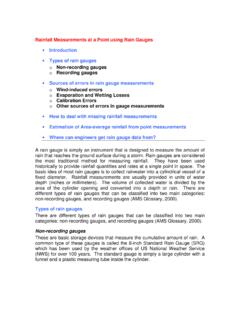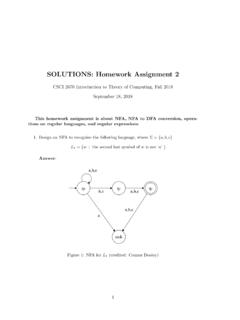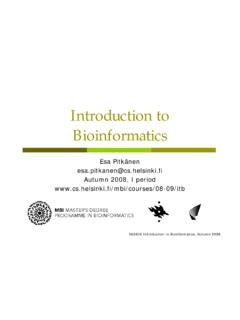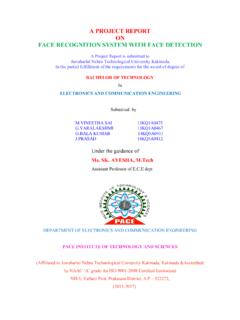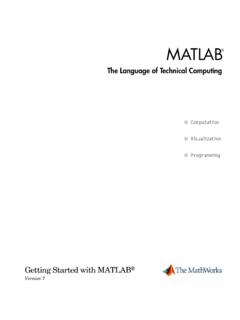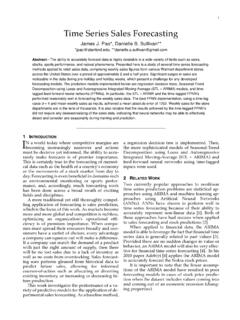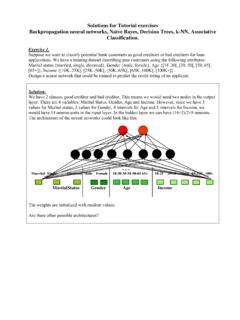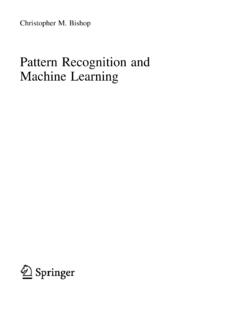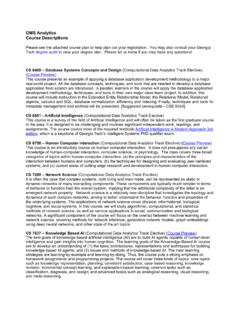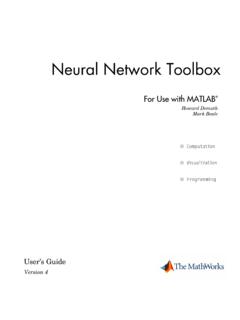Transcription of Introduction to Computational Intelligence
1 Introduction to Computational IntelligenceCSCI/ENGR 8940 Cruise Director: Don Potter(Textbook slides by Eberhartwere edited by Potter for use in CSCI/ENGR-8940)Prof. Walter D. PotterProfessor of Computer ScienceDirector, Institute for Artificial IntelligenceOffice: GSRC-113 Phone: 706-542-0361 Email: Computational Intelligence : Concepts to Implementations by Eberhart and ShiOutline of class session Introduction Discuss handout Review course outline Individual introductions Resources in addition to textbookIntro. to Cl: Course Outline (maybe) Introduction Foundations of CI Evolutionary Computation neural Networks Fuzzy Logic Computational Intelligence Metrics and Analysis Case StudiesIntroduction Definition of Computational Intelligence Advantages of Cl tools* Can be implemented by domain experts* Relatively short development time This course is applications-oriented* Can solve tough problems Book software assumes students have knowledge of:* C programming Applications selected based on.
2 * Basic concepts,* Experience/practice,* Cool,* Impact factorComputational Intelligence DefinitionComputational Intelligence comprises practical adaptation and self-organizationconcepts, paradigms, algorithms and implementations that enable or facilitate appropriate actions (intelligent behavior) in complex and changing of BookChapter 1 FoundationsChapter 2 Computational IntelligenceChapter 3 Evolutionary ComputationChapter 4 Evolutionary Computation ImplementationsChapter 5 Artificial neural NetworksChapter 6 neural network ImplementationsChapter 7 Fuzzy SystemsChapter 8 Fuzzy System ImplementationsChapter 9 Computational Intelligence ImplementationsChapter 10 Performance MetricsChapter 11 Analysis and ExplanationChapter 12 Case Study SummariesAppendix Computational Intelligence ResourcesGlossaryNote.
3 Chapter 12 and glossary are on book s Chapter Technical and historical discussion of component technologies Foundationsreviews background of component technologies Defines terms; relates to biology and behavioral motivations; discusses myths ; reviews applicationsComputational Intelligence Introduction to Computational Intelligence Adaptation Self-organization Computational Intelligence systems How CI fits into the environment Soft computingEvolutionary Computation History: reviews development history of EC with focus on people Concepts, paradigms and implementations of evolutionary algorithms Evolutionary Computation Theory and Paradigms:reviews genetic algorithms, evolutionary programming, evolution strategies, and genetic programming.
4 Evolutionary Computation Implementations: genetic algorithm and particle swarm Networks neural network concepts, paradigms, and implementations. neural network Theory and Paradigms: terminology, biological bases, survey of architectures and topologies, review of learning paradigms and recall procedures. neural network Implementations: back-propagation, self-organizing feature maps, and learning vector Systems Theory, concepts and implementations of fuzzy logic and fuzzy systems. Fuzzy Systems Theory and Paradigms: Fuzzy logic terminology and symbology, fuzzy logic theorems, differences with probability, steps in applying fuzzy logic. Fuzzy Systems Implementation:fuzzy expert Intelligence Implementations Implementation issues including GA and fuzzy adaptation The fuzzy evolutionary fuzzy rule system implementation Packages: EnCog, Neuroph, Neuroshell, Weka, Matlab, Roll-Your-Own, etc.
5 Choosing/using the best methodsMetrics and Analysis Tools needed for CI system development. Performance Metrics:methods for measuring and representing the performance of Computational Intelligence tools. Analysis and Explanation Facilities:graphical representation of neural network weights, development of explanation facilities for CI systems, example of explanation facility for a neural Studies From Book Detection of epileptiform spikes Battery state of charge Schedule optimization Human tremor analysis Control system neural network approach Fuzzy logic approachOur Case Studies Multiple Fault Diagnosis network Configuration Harvest Scheduling Multiple Recursive Generators Snake in the Box Solar Radiation Prediction Temperature Prediction OthersThis course is about.
6 Computational tools for uses in practical applications Self-organization Complex adaptive systemsThis course is not about: Everything there is to know about CI and its components Lots of mathematical derivations and proofs Agents Life (whatever that is)Foundations -Outline Introduction Definitions Biological/behavioral bases Myths Application areasIntroduction Focus on practical applications Emphasize the PC platform Implementation is up to youDefinition of IntelligenceWebster s New Collegiate Dictionary defines Intelligence as 1a(1) : The ability to learn or understand or to deal with new or trying situations : REASON; also: the skilled use of reason (2) : the ability to apply knowledge to manipulate one s environment or to think abstractly as measured by objective criteria (as tests).
7 Another Definition of Intelligence The capability of a system to adapt its behavior*to meet its goals in a range of environments. It is a property of all purpose-driven decision Fogel* implement decisions Definition: Evolutionary ComputationMachine learning optimization and classification paradigms roughly based on mechanisms of evolution such as naturalselection and biological genetics. Includesgenetic algorithms, evolutionary programming,evolution strategies and genetic : Artificial neural network An analysis paradigm very roughly modeled afterthe massively parallel structure of the brain. Simulates a highly interconnected, parallel Computational structure with numerous relatively simple individual processing : FuzzinessFuzziness: Non-statistical imprecision and vagueness in information and data.
8 Fuzzy Sets model the properties of properties of imprecision, approximation or vagueness. Fuzzy Membership Valuesreflect the membershipgrades in a set. Fuzzy Logicis the logic of approximate reasoning. It is a generalization of conventional DefinitionsParadigm: A particular choice of attributes for a example is the back-propagation paradigmthat is included in the neural network other words, it is a specific example of : A computer program written andcompiled for a specific computer or class of computersthat implements a ComputingSoft computing is not a single methodology. Rather, it is a consortium of computing methodologies which collectively provide a foundation for the conception, design and deployment of intelligent systems.
9 At this juncture, the principal members of soft computing are fuzzy logic, neurocomputing, genetic computing, and probabilistic computing, with the last subsuming evidential reasoning, belief networks, chaotic systems, and parts of machine learning theory. In contrast to traditional hard computing, soft computing is tolerant of imprecision, uncertainty and partial truth. The guiding principle of soft computing is: exploit the tolerance for imprecision, uncertainty and partial truth to achieve tractibility, robustness, low solution cost and better rapport with ZadehDefinition of Computational IntelligenceA methodology involving computing that exhibits an ability to learn and/or to deal with new situations, such that the system is perceived to possess one or more attributes of reason, such as generalization, discovery, association and Computational Intelligence systems usually comprise hybrids of paradigms such as artificial neural networks, fuzzy systems, and evolutionary algorithms, augmented with knowledge elements.
10 And are often designed to mimic one or more aspects of carbon-based biological Intelligence DefinitionComputational Intelligence comprises practical adaptation and self-organization concepts, paradigms, algorithms, and implementations that enable or facilitate appropriate actions (intelligent behavior) in complex and changing Basis: neural NetworksNeurons: nerve cells; consist of dendrites, body and an axon; signals flow through differences between biological and artificialneurons (processing elements):* Signs of weights (+ or -)* Signals are AC in neurons, DC in PEs* Many types of neurons in a system; usually onlya few at most in neural networks* Basic cycle time for PC (~100 ns) faster thanbrain (10-100ms) {as far as we know!}



